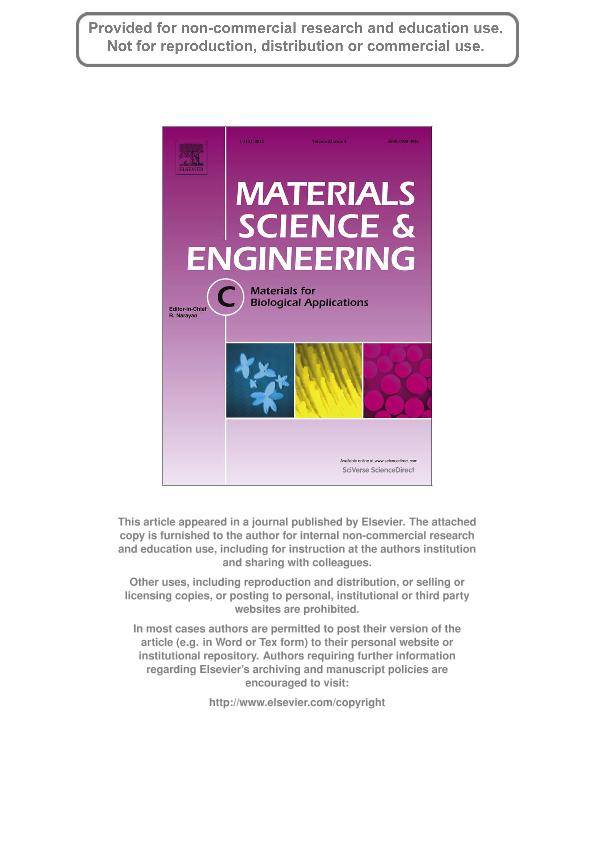Mostrar el registro sencillo del ítem
dc.contributor.author
Fanovich, Maria Alejandra

dc.contributor.author
Jaeger, P.
dc.date.available
2016-07-01T18:40:51Z
dc.date.issued
2012-02-09
dc.identifier.citation
Fanovich, Maria Alejandra; Jaeger, P.; Sorption and diffusion of compressed carbon dioxide in polycaprolactone for the development of porous scaffolds; Elsevier; Materials Science & Engineering. C, Biomimetic Materials, Sensors And Systems; 32; 4; 9-2-2012; 961-968
dc.identifier.issn
0928-4931
dc.identifier.uri
http://hdl.handle.net/11336/6297
dc.description.abstract
In this work different phenomena related to sorption of carbon dioxide in polycaprolactone (PCL) have been investigated systematically. The use of compressed carbon dioxide is discussed for obtaining porous scaffolds from this biocompatible polymer. In order to determine the plasticization effect of carbon dioxide on the degree of foaming it is necessary to discuss sorption data with respect to morphological features of the polymer at conditions nearby the melting point. The amount of carbon dioxide dissolved and the kinetics of the sorption process are found to depend strongly on temperature and pressure. The solubility takes values of up to 25 wt.% being favoured by a melting and glass transition temperature depression which can be observed along with an enhanced mass transfer rate. In general, CO2 sorption in PCL increases linearly with pressure. When decompressing, microfoaming occurs which enhances the rate of gas release. Changes in morphology and crystallinity occur as a consequence of the pressure treatment. Compared to the melting temperature at atmospheric pressure there is a dramatic reduction observed under pressure where melting occurs already at a temperature below 40 °C. Even after pressure-treatment, there is a remaining change in melting temperature and crystallinity observed. Optimum conditions for obtaining adequate porous scaffolds of PCL are a relatively slow decompression after treatment at 17 MPa and 35 °C.
dc.format
application/pdf
dc.language.iso
eng
dc.publisher
Elsevier

dc.rights
info:eu-repo/semantics/openAccess
dc.rights.uri
https://creativecommons.org/licenses/by-nc-nd/2.5/ar/
dc.subject
Polycaprolactone
dc.subject
Supercritical Carbon Dioxide
dc.subject
Porous Scaffolds
dc.subject.classification
Ingeniería de los Materiales

dc.subject.classification
Ingeniería de los Materiales

dc.subject.classification
INGENIERÍAS Y TECNOLOGÍAS

dc.subject.classification
Físico-Química, Ciencia de los Polímeros, Electroquímica

dc.subject.classification
Ciencias Químicas

dc.subject.classification
CIENCIAS NATURALES Y EXACTAS

dc.title
Sorption and diffusion of compressed carbon dioxide in polycaprolactone for the development of porous scaffolds
dc.type
info:eu-repo/semantics/article
dc.type
info:ar-repo/semantics/artículo
dc.type
info:eu-repo/semantics/publishedVersion
dc.date.updated
2016-06-08T17:51:41Z
dc.journal.volume
32
dc.journal.number
4
dc.journal.pagination
961-968
dc.journal.pais
Países Bajos

dc.journal.ciudad
Amsterdam
dc.description.fil
Fil: Fanovich, Maria Alejandra. Consejo Nacional de Investigaciones Científicas y Técnicas. Centro Científico Tecnológico Mar del Plata. Instituto de Investigación En Ciencia y Tecnología de Materiales (i); Argentina. Universidad Nacional de Mar del Plata. Facultad de Ingeniería; Argentina
dc.description.fil
Fil: Jaeger, P.. Hamburg University of Technology; Alemania
dc.journal.title
Materials Science & Engineering. C, Biomimetic Materials, Sensors And Systems

dc.relation.alternativeid
info:eu-repo/semantics/altIdentifier/url/http://www.sciencedirect.com/science/article/pii/S0928493112000732
dc.relation.alternativeid
info:eu-repo/semantics/altIdentifier/doi/10.1016/j.msec.2012.02.021
dc.relation.alternativeid
info:eu-repo/semantics/altIdentifier/doi/http://dx.doi.org/10.1016/j.msec.2012.02.021
Archivos asociados
